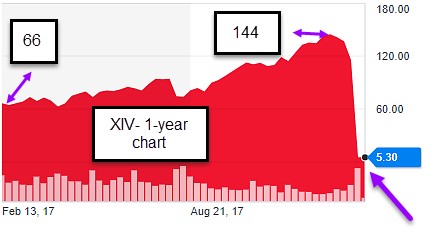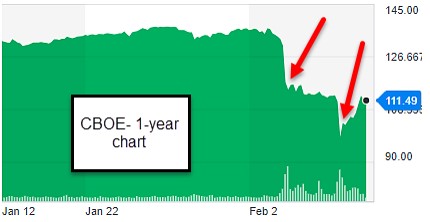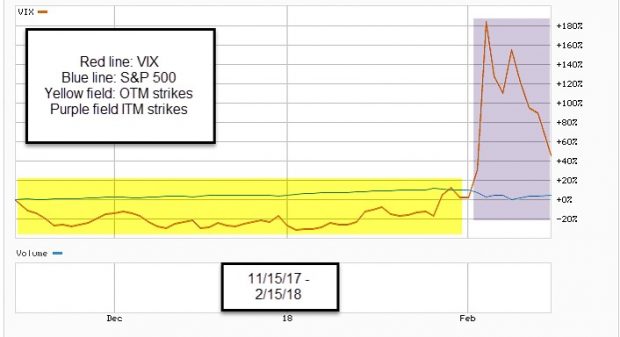Our covered call writing and put-selling portfolios have been significantly impacted the past few weeks from extreme market volatility. In addition to rising wages, inflation concerns and projected interest rate hikes, volatility based exchange-traded notes are also playing a role in the market decline.
What is the VIX?
The VIX is also known as the CBOE Volatility Index. It demonstrates the market’s expectation of 30-day volatility based on option-pricing. It measures market risk and is frequently called the investor fear gauge.
What are exchange-traded notes (ETNs)?
ETNs are unsecured debt securities based on the performance of a market benchmark, like the VIX, less applicable fees. They are traded on major US exchanges during traditional trading hours. ETNs have a maturity and are backed only by the credit of the issuer, a key factor to consider. When they mature, the financial institution takes out fees and gives the investor cash based on the performance of the underlying index.
Risks of ETNs
- Investors must be directionally correct on index and cover expenses as well
- The issuer may not be able to pay the cash on time
- The issuer may default on the loan
- Limited secondary market may result in large losses or gains
- FINRA has warned against volatility-linked ETNs and even required Wells Fargo (NYSE:WFC) to pay investors $3.4 million for improper sales of these products
Current market and ETNs
In 2017, the VIX was historically low, remaining under 15 while the S&P 500 returned more than 20%. Many hedge funds were playing the current market conditions by purchasing stocks and ETNs that targeted a declining market volatility. This strategy works when the market continues to accelerate and volatility remains low. But we all know what transpired the past few weeks. Wage growth, inflation concerns and projections of interest rate hikes rattled the market causing significant price declines and dramatic increases in volatility. The screenshot below shows a tripling of the VIX in the past month:

Volatility Spikes as Market Declines
Many inverse-VIX ETNs lost more than 90% of their value as a result of the trade no longer working. The chart below, shows the VelocityShares Daily Inverse VIX Short-Term ETN (XIV) dropping from 144 to 5 in a few days:

XIV Drops more than 90% in a Few Days
These events with volatility-based inverse ETNs have resulted in a secondary exacerbation of market volatility as institutional investors unwind these ETN positions and sell stock shares to reduce their leverage. Investors are concerned about VIX-related trading volume and revenues declining and impacting the CBOE itself because 25% of CBOE global market revenue is generated from VIX-related products. This concern is reflected in the chart below:

CBOE Price Decline
Discussion
Volatility-based ETNs are extremely risky and not appropriate for most retail investors. However, it is beneficial to understand how these products may be a secondary factor in impacting our option-selling positions in extreme market conditions.
Volatility and our covered call positions (re-published from last week’s blog commentary)
Many of our members who have never experienced the type of market volatility we have experienced recently have been inquiring about how to incorporate volatility into our investment decisions. I have moved from more aggressive positions (out-of-the-money strikes) to more defensive positions (in-the-money strikes). Both can generate cash into our brokerage accounts. I will also be discussing volatility in this weekend’s blog article.
All other factors being the same, I favor OTM strikes when the VIX is below 20 and either declining or consolidation (moving sideways). I favor ITM strikes when the VIX moves above 20 and confirms the inverse relationship between the VIX and the S&P 500.
It is so important to trade in a non-emotional manner as aberrations like we recently have been experiencing will rear their ugly heads from time-to-time and we need to eliminate fear and greed from our trading influences.
It is true that a market acceleration can make ITM strikes appear to be a bad decision but in an environment of high volatility, defensive trading makes more sense especially for retail investors looking to generate cash-flow in a low-risk manner.
The chart I created below highlights how I address volatility and my option-selling positions as they relate to volatility:

Volatility and our Covered Call Positions
THE WEEK AHEAD
Mon Feb 19th
- None: President’s day
Tue Feb 20th
- None
Wed Feb 21st
- Markit manufacturing PMI Feb
- Markit services PMI
- Existing home sales
Thu Feb 22nd
- Weekly jobless claims through 2/17
- Leading economic indicators Jan
Fri Feb 23rd
- None
For the week, the S&P 500 rose by 4.30% for a year-to-date return of 2.19%%
Summary
IBD: Market in confirmed uptrend
GMI: 2/6- Sell signal since market close of February 7, 2018
BCI: Due to the market volatility, I will be selling only in-the-money calls until market volatility subsides. I remain bullish on the economy and the market moving forward.
WHAT THE BROAD MARKET INDICATORS (S&P 500 AND VIX) ARE TELLING US
The 6-month charts point to a neutral outlook. In the past six months, the S&P 500 was up 11% while the VIX (19.46) moved up by 64%.
Wishing you much success,
